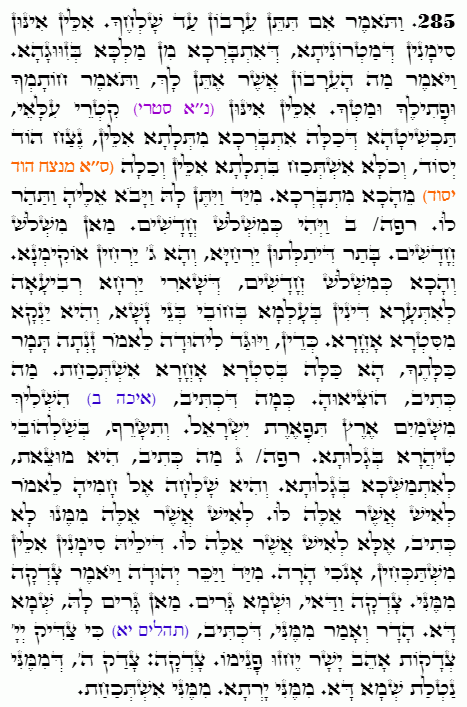Daily Zohar # 4674 – Acharei Mot – What pledge shall I give you?
Daily Zohar 4674

Hebrew translation:
.
Zohar Acharei Mot
Continued from previous DZ
#285
Genesis 38:18
“וַיֹּאמֶר מָה הָעֵרָבוֹן אֲשֶׁר אֶתֶּן לָּךְ וַתֹּאמֶר חֹתָמְךָ וּפְתִילֶךָ וּמַטְּךָ אֲשֶׁר בְּיָדֶךָ וַיִּתֶּן לָּהּ וַיָּבֹא אֵלֶיהָ וַתַּהַר לוֹ.”
“Then he said, “What pledge shall I give you?” So she said, “Your signet and cord, and your staff that is in your hand.” Then he gave them to her and went into her, and she conceived by him.”
And she said, “If you give a pledge until you send it.” These are the signs of the Queen (Malchut), who was blessed by the King (Zeir Anpin) through their unification. And he said, “What pledge shall I give you?” And she said, “Your seal, cord, and staff.” These are the upper connections, the adornments of the bride (Malchut), who is blessed through these three: Netzach, Hod, and Yessod. Everything exists within these three, and they bless the bride (Malchut). Immediately, “He gave them to her, and he came to her, and she conceived by him.
Genesis 38:24
“וַיְהִי כְּמִשְׁלֹשׁ חֳדָשִׁים וַיֻּגַּד לִיהוּדָה לֵאמֹר זָנְתָה תָּמָר כַּלָּתֶךָ וְגַם הִנֵּה הָרָה לִזְנוּנִים וַיֹּאמֶר יְהוּדָה הוֹצִיאוּהָ וְתִשָּׂרֵף.”
“And it came to pass, about three months after, that Yehuda was told, saying, “Tamar, your daughter-in-law has played the harlot; furthermore, she is with child by harlotry.” So Yehuda said, “Bring her out and let her be burned!”
“And it came to pass after three months.” The Zohar asks: What does ‘after three months’ mean? It explains that after three months, The three months symbolize the three sefirot of Chessed, Gevurah, and Tiferet. Here it says “after three months” (כמשלש חדשים), meaning when the fourth month, which represents Malchut, began to awaken judgments in the world due to the sins of people, and Malchut draws from the ‘other side’ (Sitra Achra). Then it was told to Judah, “Tamar, your daughter-in-law, has committed adultery.” The bride (Malchut) is now found on the side of impurity. What is written next? “Bring her out” – this is as it is written,
Lamentations 2:1
“אֵיכָה יָעִיב בְּאַפּוֹ אֲדֹנָי אֶת בַּת צִיּוֹן הִשְׁלִיךְ מִשָּׁמַיִם אֶרֶץ תִּפְאֶרֶת יִשְׂרָאֵל וְלֹא זָכַר הֲדֹם רַגְלָיו בְּיוֹם אַפּוֹ.”
“How the Lord has covered the daughter of Zion With a cloud in His anger! He cast down from heaven to the earth The splendor of Israel, And did not remember His footstool In the day of His anger.”
“He cast down from heaven to earth the splendor of Israel.” “And let her be burned” – signifies the burning in the flame of fire during exile.
Genesis 38:25
“הִוא מוּצֵאת וְהִיא שָׁלְחָה אֶל חָמִיהָ לֵאמֹר לְאִישׁ אֲשֶׁר אֵלֶּה לּוֹ אָנֹכִי הָרָה וַתֹּאמֶר הַכֶּר נָא לְמִי הַחֹתֶמֶת וְהַפְּתִילִים וְהַמַּטֶּה הָאֵלֶּה.”
“When she was brought out, she sent to her father-in-law, saying, “By the man to whom these belong, I am with child.” And she said, “Please determine whose these are—the signet, cord, and staff.”
What is written? “She was being brought out” – this signifies the continuation of the exile. “And she sent to her father-in-law, saying, ‘By the man to whom these belong, I am pregnant.'” It does not say “by the man from whom,” but rather “by the man to whom these belong,” meaning that these signs (the seal, cord, and staff) were originally his, and now, through them, I am pregnant. These were the bride’s adornments, which had now become hers, as explained before, although he gave them to her. Immediately, Yehuda recognized them and said, “She is more righteous (צדקה) than I.” Indeed, she is righteous, and the name caused it. For so is Malchut named צדק. What gave her this name? He continued and said, “From me” – as it is written,
Psalm 11:7
“כִּי צַדִּיק יְהוָה צְדָקוֹת אָהֵב יָשָׁר יֶחֱזוּ פָנֵימוֹ.”
“For YHVH is righteous, He loves righteousness (צְדָקוֹת), the upright shall behold His face.” For righteousness (צדקה) is the justice (צדק) of Hashem, and from me, she received this name. From me, she inherited it, and from me, it exists.
Notes:
This passage of the Zohar interprets the dialogue between Yehuda and Tamar as the spiritual relationship between Zeir Anpin (the King) and Malchut (the Queen). The “pledge” Tamar requests signifies the spiritual symbols and blessings that Malchut receives through its union with Zeir Anpin.
The “seal, cord, and staff” represent the three sefirot: Netzach, Hod, and Yessod. These sefirot play a crucial role in the flow of the Light from the higher levels into the lower, blessing Malchut. These three sefirot are referred to as the bride’s adornments, highlighting their importance in the spiritual interaction between Zeir Anpin and Malchut.
When Yehuda (representing Zeir Anpin) gives these to Tamar (representing Malchut), it symbolizes the transmission of Light and blessings, enabling Malchut to conceive and bring forth sustenance and abundance. This union signifies the continuous flow of the Light that sustains the world.
The deeper meaning behind the story focuses on the three months and the subsequent punishment. The three months represent the sefirot of Chessed, Gevurah, and Tiferet, which govern light flow from the higher levels. When these are completed, the fourth level is linked to the world below, Malchut.
In this case, Malchut awakens judgments and severity when people’s sins influence it and draw from the “other side.” Tamar, representing Malchut, is accused of sin, and this parallels the idea of the Shechinah being exiled and falling under the influence of external forces (חיצונים). The command to “bring her out” (הוציאוה) and “let her be burned” (ותשרף) symbolizes the Shechinah’s suffering in exile, akin to being cast down and “burned” in the trials and tribulations of this world.
Another important teaching from this story;
https://www.sefaria.org/Berakhot.43b.8?lang=bi&with=all&lang2=en
The Talmud (Berachot 43b) states in the name of Rabbi Shimon bar Yochai: ‘It is better for a person to throw themselves into a fiery furnace than to embarrass someone else in public.’ From where do we learn this? From Tamar, as it says (Genesis 38): ‘She was being brought out…'”
This saying underscores the value of human dignity and the lengths to which one should go to avoid publicly shaming another. According to this teaching, even facing death—symbolized by the fiery furnace—is preferable to publicly humiliating someone.
The connection to Tamar from the story in Genesis (Chapter 38) is profound. Tamar, after becoming pregnant by Yehuda, was accused of infidelity, a crime punishable by death at that time. Instead of immediately revealing that Yehuda was the father (which would have saved her life), Tamar subtly sent Yehuda the items he had given her—his signet ring, cord, and staff—allowing him to recognize the truth on his own. By doing this, she avoided publicly embarrassing Yehuda. This self-sacrifice shows her deep sense of dignity and righteousness, which the Talmud regards as a model of the principle that it is better to risk one’s life than to cause public humiliation.
Tamar’s actions embody Rabbi Shimon’s teaching. Even though revealing Yehuda’s identity would have immediately exonerated her, she risked her life to protect his dignity. Her behavior exemplifies the ethical teaching that sparing others from shame, even at great personal cost, is an ultimate act of kindness and righteousness.
Through this act of Tamar and Yehuda, the root of the soul of the Messiah entered the world.
{||}

 Previous: Acharei Mot
Previous: Acharei Mot

